Stadiums have long been iconic symbols of human achievement in architecture, design, and culture.
However, with the growing global emphasis on sustainability, environmental responsibility, and green technology, a new wave of eco-friendly stadiums has emerged.
These stadiums not only host thrilling sports and entertainment events but also serve as beacons of sustainable architecture and eco-consciousness.
By integrating renewable energy, water conservation, and recycling programs, these stadiums are leading the way in minimizing their environmental footprint.
In this article, we will explore five of the world’s most innovative and eco-friendly stadiums that showcase how the future of sports venues can be both exhilarating and environmentally responsible.
Top 5 Eco-Friendly Stadiums
1. Mercedes-Benz Stadium (Atlanta, USA)
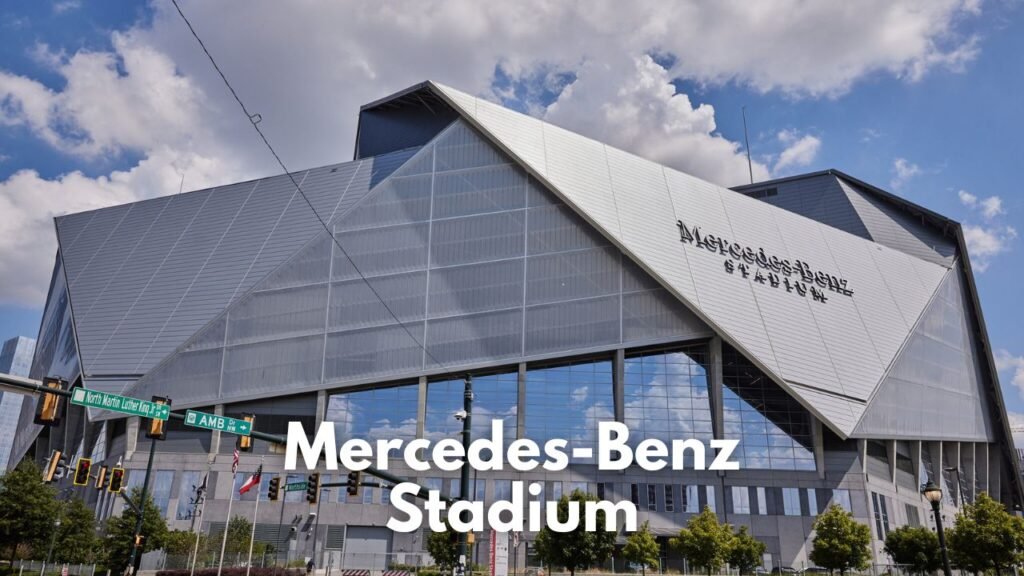
Opened in 2017, the Mercedes-Benz Stadium in Atlanta, Georgia, is a cutting-edge example of sustainable sports architecture.
Home to the Atlanta Falcons (NFL) and Atlanta United (MLS), this stadium stands out not only for its futuristic design but for its profound commitment to eco-friendliness.
Key Eco-Friendly Features
- LEED Platinum Certification: The Mercedes-Benz Stadium was the first professional sports stadium in the US to earn LEED Platinum certification, the highest level of sustainability recognition awarded by the U.S. Green Building Council.
- Solar Power: The stadium boasts over 4,000 solar panels, which generate more than 1.6 million kilowatt-hours of energy annually—enough to power 160 homes in the area.
- Water Conservation: With an impressive stormwater capture system, the stadium can hold over 2 million gallons of rainwater, reducing flooding risks and conserving water for use in landscaping.
- Recycling and Waste Reduction: A robust recycling program is in place, and the stadium’s commitment to reducing waste has resulted in significant waste diversion from landfills during events.
The Mercedes-Benz Stadium is setting a new standard for how sports venues can integrate sustainability into their design and operations.
The combination of solar energy, water conservation, and recycling programs significantly reduces the stadium’s carbon footprint, making it a model for future eco-friendly stadiums around the world.
Checkout:
2. Levi’s Stadium (Santa Clara, USA)

Levi’s Stadium, home to the San Francisco 49ers, is one of the most environmentally progressive stadiums in the United States.
Since opening in 2014, it has garnered widespread attention for its sustainable design and operational strategies that reduce environmental impact.
Key Eco-Friendly Features
- Green Roof: Levi’s Stadium is equipped with a 27,000-square-foot green roof atop its suite tower, which provides insulation, improves air quality, and helps with stormwater management.
- Recycled Water System: The stadium features an advanced recycled water system that uses reclaimed water for irrigation, cooling, and toilet flushing, helping to conserve fresh water.
- Solar Energy: With 1,162 solar panels, Levi’s Stadium generates enough electricity annually to offset the power used during home games, creating a net-zero energy experience for fans.
- LEED Gold Certification: Like the Mercedes-Benz Stadium, Levi’s Stadium has achieved LEED Gold certification for its environmentally responsible design.
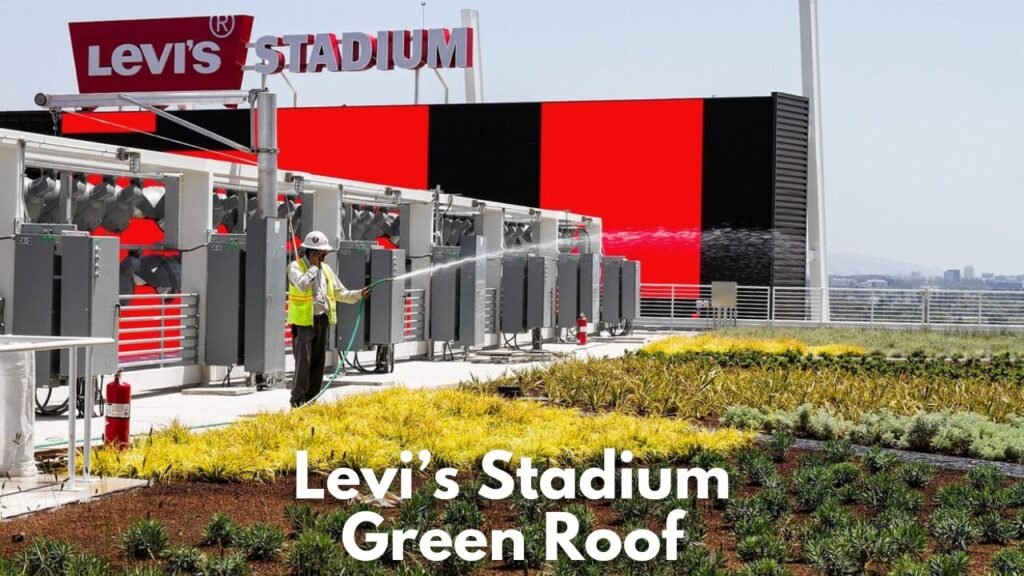
Levi’s Stadium is a pioneer in the use of recycled water and solar energy to minimize its environmental impact.
By implementing sustainable technologies, the stadium significantly reduces water consumption, greenhouse gas emissions, and energy use, demonstrating how large-scale venues can operate sustainably.
Checkout:
3. Johan Cruyff Arena (Amsterdam, Netherlands)
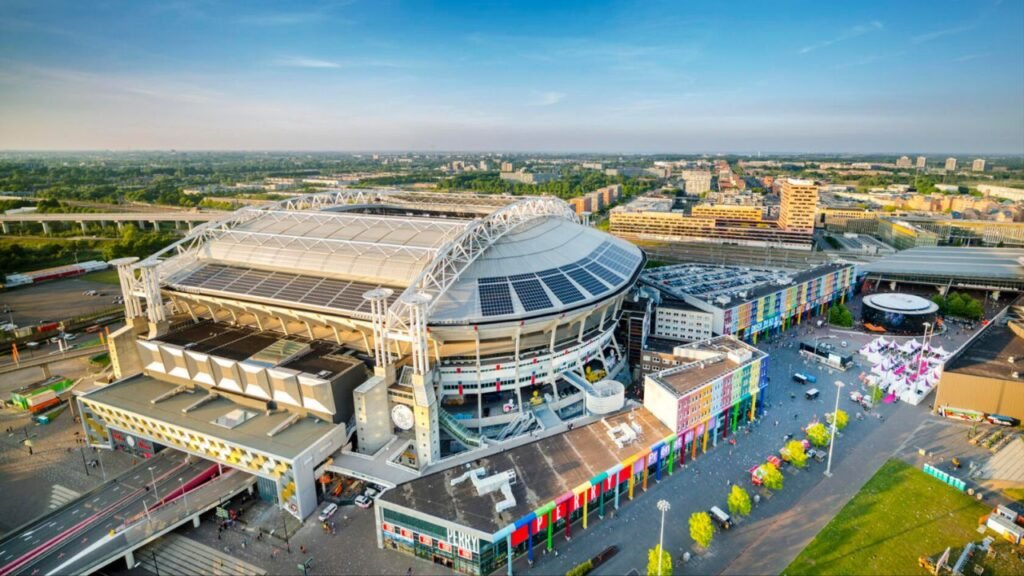
The Johan Cruyff Arena, named after the legendary Dutch footballer, is home to AFC Ajax and one of Europe’s most innovative eco-friendly stadiums.
Since its opening in 1996, the stadium has undergone multiple upgrades to become one of the most eco-friendly stadiums and sustainable sports venues in the world.
Key Eco-Friendly Features
- Energy Storage System: The stadium is equipped with a 3-megawatt energy storage system using second-life batteries from electric vehicles (EVs). This system can store energy from solar panels on the roof and help stabilize the local power grid.
- Solar Power: Over 4,200 solar panels have been installed on the stadium’s roof, providing renewable energy to power various stadium operations.
- Waste Management: The arena has a comprehensive waste separation and recycling program that ensures minimal waste ends up in landfills.
- Smart Lighting: The Johan Cruyff Arena uses LED lighting throughout the venue, reducing energy consumption by up to 30%.
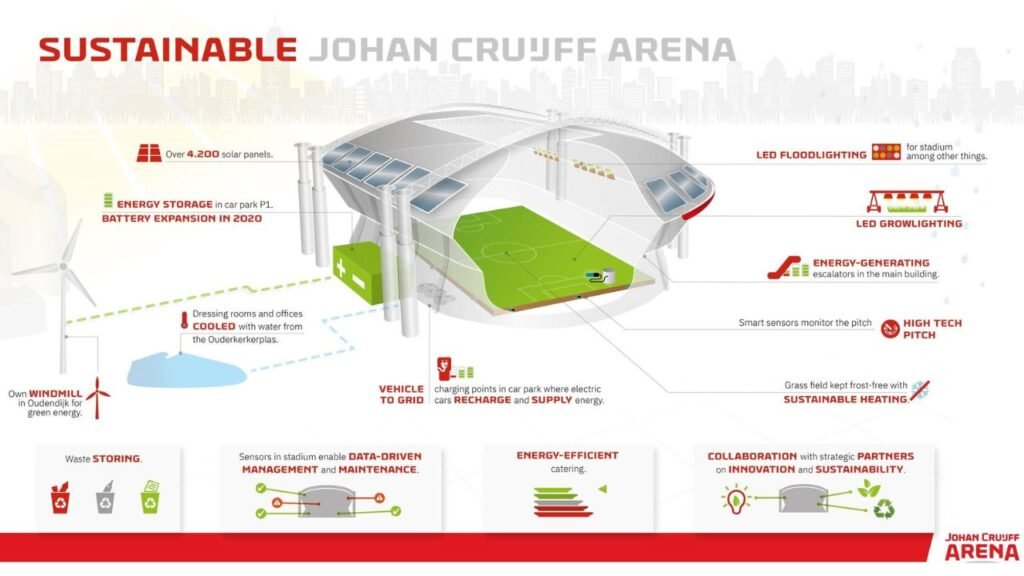
The Johan Cruyff Arena stands out for its innovative use of EV batteries for energy storage, allowing the stadium to contribute to the local power grid and reduce peak energy demand.
Additionally, its focus on waste reduction, solar energy, and energy-efficient lighting makes it a leader in eco-friendly stadium design in Europe.
4. Tottenham Hotspur Stadium (London, UK)

Opened in 2019, Tottenham Hotspur Stadium is one of the newest and most technologically advanced football stadiums in the world.
As the home of Tottenham Hotspur F.C., the stadium combines state-of-the-art features with an unwavering commitment to sustainability.
Key Eco-Friendly Features
- Plastic-Free Stadium: Tottenham Hotspur Stadium is committed to being a single-use plastic-free venue. The club has eliminated plastic straws, stirrers, and cutlery and has replaced plastic beer cups with biodegradable alternatives.
- Energy Efficiency: The stadium features high-efficiency LED lighting and a natural ventilation system that reduces the need for air conditioning, significantly lowering energy consumption.
- Rainwater Harvesting: A sophisticated rainwater harvesting system collects and stores rainwater for use in the stadium’s toilets and irrigation systems, reducing the venue’s overall water consumption.
- Electric Car Charging Stations: The stadium has installed numerous electric vehicle charging stations in its parking areas, encouraging fans to drive eco-friendly vehicles to matches.
With its commitment to being a plastic-free venue and its implementation of energy-saving technologies, Tottenham Hotspur Stadium demonstrates that sustainability can go hand-in-hand with innovation.
The stadium’s rainwater harvesting and energy-efficient systems significantly reduce its environmental footprint, making it one of the most sustainable venues in the world.
5. Forest Green Rovers Stadium (Nailsworth, UK)
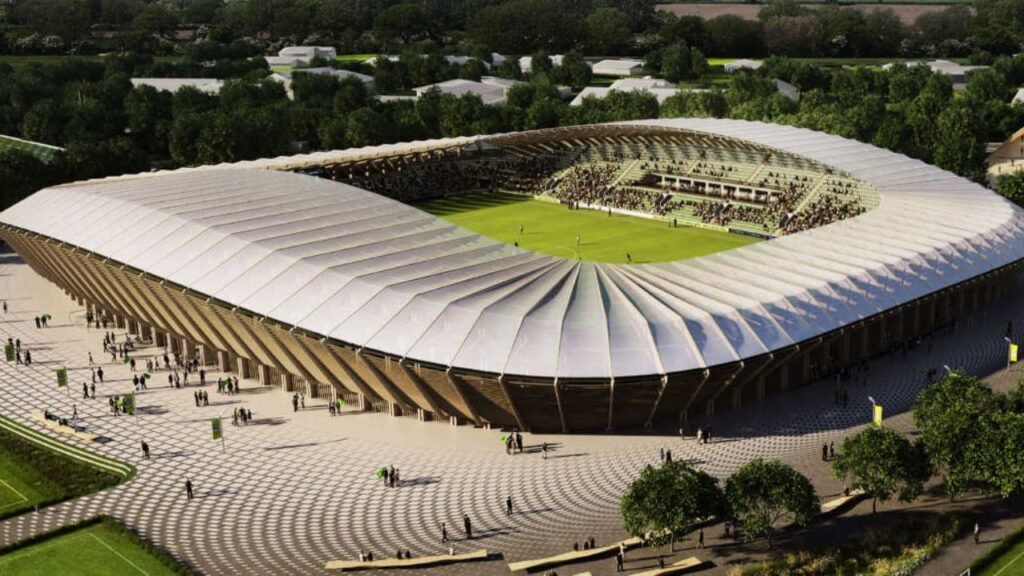
Forest Green Rovers, a football club playing in League Two of the English Football League, is widely regarded as the world’s most sustainable football club.
Their stadium, The New Lawn, is a testament to the club’s dedication to environmental sustainability.
Key Eco-Friendly Features
- Solar Power: Solar panels installed on the stadium’s roof generate a significant portion of the club’s energy needs, ensuring that matchdays are powered by renewable energy.
- Organic Pitch: The New Lawn features an organic football pitch, meaning no pesticides or chemicals are used in the maintenance of the grass.
- Vegan Menu: In a unique twist, the stadium offers a 100% vegan menu, reflecting the club’s commitment to reducing its carbon footprint and promoting a plant-based lifestyle.
- Wooden Stadium Plan: The club has announced plans to build a new stadium made almost entirely of wood, which will be the world’s first all-wood football stadium, reducing the embodied carbon emissions by 75% compared to conventional stadiums.
Forest Green Rovers have redefined what it means to be an eco-friendly sports team.
By integrating solar power, organic landscaping, and a vegan menu, the club’s stadium offers a blueprint for how even small venues can make a big impact on the environment.
The forthcoming wooden stadium is a bold and visionary project that could revolutionize sustainable stadium design worldwide.
Conclusion: The Future of Eco-Friendly Stadiums
As the world continues to face the challenges of climate change and environmental degradation, sports venues must play a critical role in adopting and promoting sustainable practices.
The eco-friendly stadiums highlighted in this article—Mercedes-Benz Stadium, Levi’s Stadium, Johan Cruyff Arena, Tottenham Hotspur Stadium, and Forest Green Rovers Stadium—are leading the charge in showing how large-scale venues can operate responsibly and minimize their impact on the environment.
By investing in renewable energy, water conservation, and waste reduction, these stadiums are proving that it is possible to create thrilling fan experiences while reducing the environmental footprint.
As more stadiums embrace sustainable architecture and operations, the sports industry will continue to inspire millions of people to think about the future of our planet.



